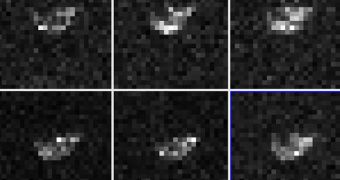The discovery of the asteroid 2007 TU24 represents for astronomers a golden opportunity to learn more about these rogue bodies, as it will pass about 534,000 kilometers over the surface of the Earth. From 27th to 28th of January and from 1st to 4th of February, the Arecibo Radio Observatory in Puerto Rico will make detailed measurements and images on 2007 TU 24 before it falls back into the immensity of space.
Discovered in October 2007 by the University of Arizona's Cataline Sky Survey, asteroid 2007 TU24 poses no threat of colliding with Earth, not now or in the distant future. However, except a rough estimate of its diameter and its orbit, almost nothing is known about it. It has been catalogued as a large asteroid, ranging somewhere between 150 to 600 meters wide, and astronomers say such objects come through the vicinity of the Earth about once every 5 years or so, meaning that collisions between the Earth and similar asteroids usually take place once every 36,000 years.
Arecibo is the most powerful radio observatory on Earth, almost three times more precise than the best radio telescope operated by NASA, the Goldenstone telescope. The close approach of 2007 TU24 will enable it to accurately measure its size, spin around its axis, after which the telescope will get into radar imaging mode to take pictures of its surface with resolutions up to 7,5 meters, in order to produce a high-detail map.
There are probably more than 7,000 near-Earth objects coming periodically in the vicinity of the planet. Most of these haven't yet been discovered! The Cornell University operated observatory has previously been able to take multiple pictures of asteroids swinging by Earth, 10 percent of them presenting some special features never before observed by astronomers.
2007 TU24 is one of the largest known asteroids to come in close proximity to the Earth in the history of mankind, it will make its closest approach on the 1st of February and will not be visible to the naked eye since it will be 50 times less bright than the faintest object on the night sky.

 14 DAY TRIAL //
14 DAY TRIAL //